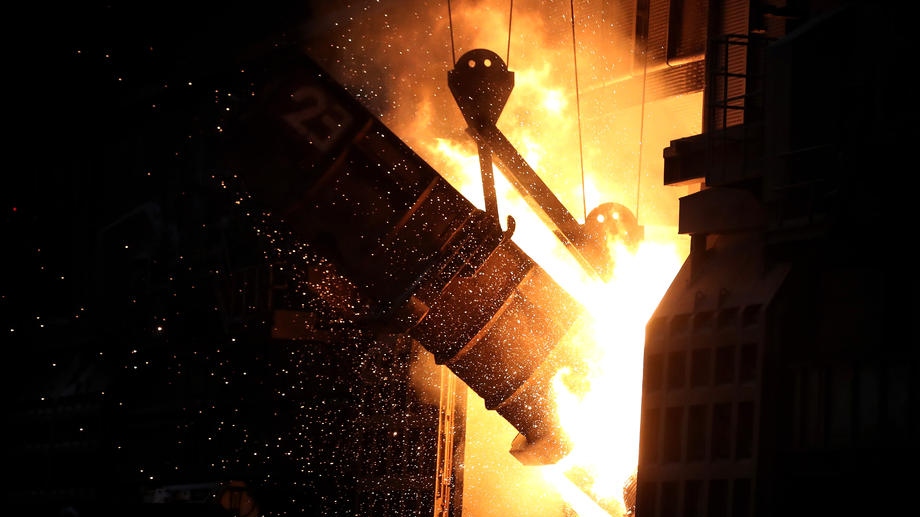Steel, cement and fertilisers should be among the first sectors covered by the upcoming carbon border levy aimed at safeguarding European businesses from cheaper CO2 intensive imports, according to Poland.
“Poland argues in favour of the implementation of a carbon border adjustment mechanism pilot phase, which would include at least the three following sectors at the beginning: steel, cement and fertilisers,” said Adam Guibourgé-Czetwertyński, undersecretary of state in the Polish Ministry of Climate and Environment.
The European Commission, which announced the border levy as part of its European Green Deal programme of environmental measures, said the goal of the proposal will be to avoid the risk of “carbon leakage” whereby companies relocate manufacturing abroad to countries where pollution costs are lower.
Although there is little evidence of carbon leakage to date, the risk is real and will only increase as the European Union adopts tougher climate goals for 2030, the EU executive said.
“We think that our approach should be both gradual and economically efficient to allow for a careful impact evaluation and a measured response to prevent carbon leakage, where it is most likely to occur,” Guibourgé-Czetwertyński said during a conference organised by Business & Science Poland, an employer’s association.

The Commission is due to reveal its long-awaited plan for a carbon border adjustment mechanism in June. It will start by covering the most carbon-intensive industries.
“We will introduce the measure into a small number of sectors. That will also help us to fine tune the measure and to do an analysis of the other different impacts,” said Vincente Hurtado Roa, deputy director at the EU executive’s taxation branch.
The idea is to protect European industries, which are facing higher carbon prices than foreign competitors in countries like China.
As soon as possible after the first phase, Hurtado Roa confirmed that the levy would expand to other sectors at risk of carbon leakage – companies moving out of Europe, where it is cheaper to emit greenhouse gases. The European Commission currently has a list of around 64 sectors at risk.
Also during the second stage, the Commission will look at introducing the levy to basic materials and what impact this would have, he added.
The carbon border adjustment mechanism will come into force in parallel with the phase-out of free allowances in the EU’s emission trading scheme (ETS), the EU’s carbon market.
These are supposed to prevent carbon leakage but came under criticism for stalling the ETS.
“This system of giving allowances for free will not work in the long run, so we have to face this. It is not an adequate measure in the long run,” said Beatriz Yordi, director for European and International Carbon Markets at the European Commission’s climate department.
But Guibourgé-Czetwertyński insisted that it is “important to keep the pool of free allowances in the ETS,” saying this is “a complementary tool with the carbon border adjustment mechanism” which have “a very different goal.”
Last month, the European Parliament seemed to back Poland’s view by rejecting proposals to scrap free ETS allowances once the planned carbon border adjustment mechanism is in place.
WTO compatibility
However, keeping the system of free allowances in place in addition to the carbon border levy would amount to double compensation for EU industries, which runs in contradiction with World Trade Organisation (WTO) rules, the European Commission warned.
Very aware of this, the EU executive insists that the carbon border levy is aimed at helping Europe meet its climate goals, not at improving the competitiveness of EU industries.
“Competitiveness is not per se an objective, it is not an objective at all. It’s not a trade measure at all – I have to say that. It’s purely an environmental measure,” said Hurtado Roa.
Another key point for the future levy’s WTO-compatibility is how the money collected will be used. Here, officials insist that the revenues generated will be recycled to finance the green transition in Europe and globally, a move aimed at alleviating concerns about WTO compatibility.
“The introduction of the measure and the design of the measure has very, very little or nothing to do with making an own resource” for the EU budget, Hurtado Roa said.
Russia to be impacted more than China
While the US is also considering some sort of levy on carbon-intensive imports, other countries have been suspicious of it. China recently slammed the idea in a call with German chancellor, Angela Merkel, and French president Emmanuel Macron.
“Tackling climate change is a shared responsibility … and should not become a geopolitical bargaining chip or used to attack other countries (or impose) trade barriers,” said Xi, according to state broadcaster CCTV.
But although China has been very vocal against the levy, it may be Russia that risks being impacted more, said Nick Mabey, chief executive at E3G, a climate think tank.
“Most of the sectors we’re talking about China has very little trade in, but Russia has a lot of trade, particularly in cross border electricity, but also in aluminium and fertiliser,” Mabey said.
“So Europe needs to talk to Russia about the implications of its new rules on border taxes,” he said.
The EU executive believes it can use the carbon border levy as leverage to persuade other countries to decarbonise. Pressure will be on companies and governments of third countries to reduce greenhouse gas emissions, said Hurtado Roa.
